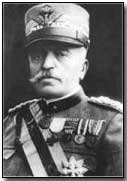Battles - The Battle of Asiago, 1916
 Tired of continually defending his line along the Isonzo River in the seemingly
endless Battles of the
Isonzo, Austro-Hungarian Chief of Staff
Conrad von
Hotzendorf resolved to mount an offensive of his own during the early part
of 1916.
Tired of continually defending his line along the Isonzo River in the seemingly
endless Battles of the
Isonzo, Austro-Hungarian Chief of Staff
Conrad von
Hotzendorf resolved to mount an offensive of his own during the early part
of 1916.
Conrad approached his German counterpart, Erich von Falkenhayn, with details of a planned attack along the Trentino designed to knock the Italians out of the war in a single combined blow.
Falkenhayn, under pressure on both Eastern and Western fronts (notably at Verdun in the west, begun in February that year), refused to commit German resources to the plan. Conrad, convinced of the soundness of the plan, nevertheless determined to press ahead without German assistance.
His plan was to drive through the Trentino's mountain passes and to occupy Italy's northern plain, thereby trapping Italian forces along the Isonzo in addition to those based in the Carnic Alps.
What transpired is an offensive alternately referred to as the Battle of Asiago and the Trentino Offensive. It was to be the sole offensive initiated by the Austro-Hungarians on the Italian Front before Caporetto in October 1917, and was the only major Austro-Hungarian action to occur away from the Isonzo.
Launched on 15 May 1916 during a lull in the Italian Isonzo offensives (of which there had been five to date, most recently in March 1916) the attack was planned by Conrad himself and nominally executed by Archduke Eugen.
The Austro-Hungarian initiative was well-timed. The Isonzo sector was quiet pending another Italian assault, and the Austro-Hungarian lines in the Balkans and in the East appeared sufficiently stable to justify action elsewhere.
Conrad therefore assembled 18 divisions of Dankl's Eleventh Army and Kovess' Third Army. As battle began the Austro-Hungarians enjoyed a notable superiority in artillery (some 2,000 guns) and outnumbered the Italians' infantry by four-to-one.
 Meanwhile
Luigi Cadorna had taken note of Conrad's actions in deploying forces to the Trentino and consequently ordered General Roberto Brusati's
Italian First Army to prepare itself for an unexpected attack.
Meanwhile
Luigi Cadorna had taken note of Conrad's actions in deploying forces to the Trentino and consequently ordered General Roberto Brusati's
Italian First Army to prepare itself for an unexpected attack.
While Cadorna's action in warning Brusati was certainly well-judged it came undone with Brusati's decision to ignore his instructions; instead he determined to continue with preparations already in hand to launch local attacks of his own.
The consequence was painful for the Italians. Archduke Eugen's Third and Eleventh armies stormed the Italian positions along a 70km front and, at least initially, succeeded in achieving substantial gains. The Italians were pushed back 8km behind Posina in the centre of their line by 22 May, and then a further 10km beyond Asiago within a further week.
Asiago itself - scene of the offensive's heaviest fighting - was evacuated by the Italians on 29 May. Fortunately for the Italians the ruggedness of the terrain served to impede the Austro-Hungarian supply chain and gave Cadorna an opportunity to save the situation.
Calling upon his Russian allies to mount a distracting offensive on the Eastern Front aimed at drawing Austro-Hungarian forces away from the Trentino (taking the form of the Russian Brusilov Offensive), he abruptly abandoned plans to continue the Fifth Battle of the Isonzo and redeployed half a million men to the Trentino by use of a highly efficient railway system.
 These
acts of sharp thinking saved the situation for the Italians and by
2 June the position in the Trentino had been stabilised. Archduke Eugen was
obliged to withdraw his troops to a position just 5km in front of where he
had started.
These
acts of sharp thinking saved the situation for the Italians and by
2 June the position in the Trentino had been stabilised. Archduke Eugen was
obliged to withdraw his troops to a position just 5km in front of where he
had started.
Casualties were heavy. In suffering approximately 150,000 losses the Austro-Hungarians were never again able to launch a major offensive without German assistance. The Italians lost around 147,000 men but, perhaps more crucially, the Trentino offensive dispelled pacifist sentiment at home amid fears of invasion. Antonio Salandra's government fell and was replaced by Paolo Boselli.
Fortunately for Luigi Cadorna military salvation was just around the corner. On 6 August 1916 he launched the Sixth Battle of the Isonzo, also known as the Battle of Gorizia, in which the Italians finally succeeded in establishing a bridgehead across the Isonzo River and in capturing Gorizia.
Click here to view a map charting the progress of the struggle at Asiago and the first eleven battles of the Isonzo.
Photographs courtesy of Photos of the Great War website
"Harry Tate" was the nickname given by British pilots to the R.E.8 aircraft
- Did you know?
